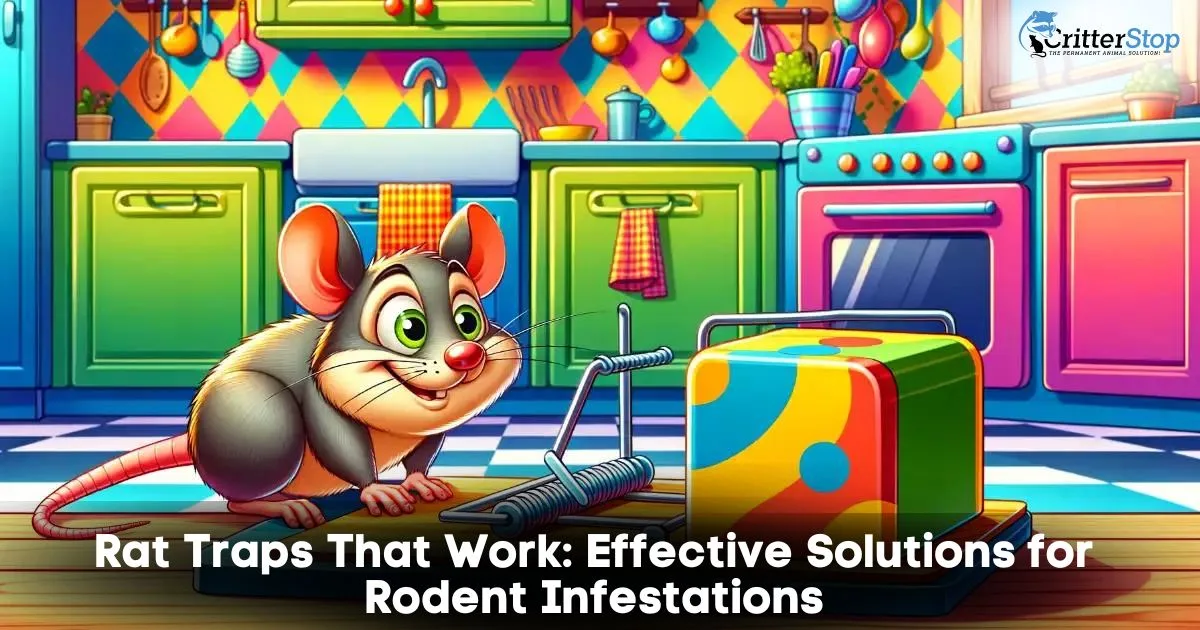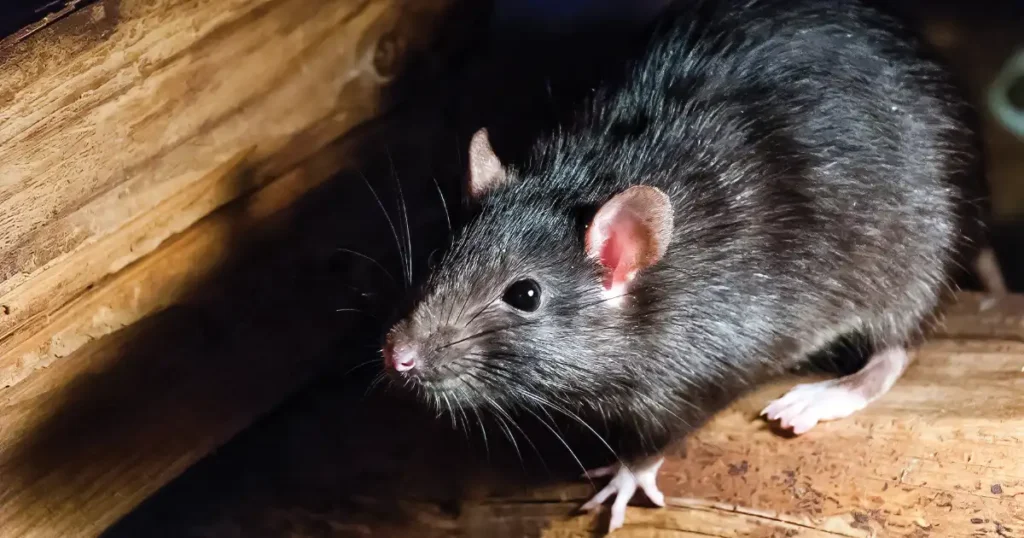
Rats are a common nuisance in many households and can cause considerable harm to property and transmit illnesses. While there are numerous rat traps available on the market, not all of them work effectively. In this blog post, we'll delve into what is the best rat trap, and also what are the best rat traps that work and provide tips on how to use them.
One of the most effective rat traps is the snap trap, which works by using a spring-loaded bar to kill the rat instantly. Snap traps are inexpensive and easy to use, making them a popular choice among homeowners. Another effective trap is the electronic trap, which uses a high voltage shock to kill the rat. These traps are more expensive than snap traps but are reusable and can kill multiple rats.
When choosing a rat trap, it is essential to consider the type of bait type we'll utilize. Rats are drawn to an array of food options, such as peanut butter, cheese, and bacon. It is also important to place the trap in the right location, such as near rat droppings or in areas where rats are frequently seen. By using the right trap and bait, homeowners can effectively get rid of rats and prevent future infestations.

Rats are clever and versatile animals capable of thriving in diverse settings, ranging from cityscapes to agricultural landscapes. In order to effectively trap rats, it is important to understand their behavior and habits.
Rats are nocturnal creatures that are most active at night. They can be found in a variety of habitats, including sewers, garbage dumps, and abandoned buildings. They are also commonly found in homes and other buildings, where they can nest in walls, attics, and basements.
Rats are opportunistic eaters and will consume nearly anything, from waste and pet feed to birdseed. They are also known to eat insects, small animals, and even each other.
One of the clearest indicators of a rat invasion is the appearance of droppings. Rat feces are tiny, dark, and cylindrical. They tend to accumulate in spots frequented by rats, like close to food stores or nesting spots.
Other signs of a rat infestation include gnaw marks on food containers, walls, and other objects. Rats have strong teeth and will chew through almost anything in order to access food or nesting materials.
Overall, understanding rat behavior is key to effectively trapping and removing these pests from your home or property. By using the most effective rat traps and understanding rat habits, you can successfully eliminate a rat infestation and prevent future problems.

In the realm of pest control, finding the best rat traps can often feel like navigating a maze. Amidst the abundance of choices saturating the market, it's vital to discern those that genuinely excel in effectiveness and dependability. If you've ever pondered, "Which rat traps reign supreme?" fret not, as we're here to illuminate the most effective remedies for your rodent troubles.
First and foremost, discerning what's the best rat trap entails understanding the unique needs of your situation. A good rat trap isn't just about snapping shut; it's about delivering swift and humane results. Among the myriad options available, the most powerful rat trap emerges as the unsung hero of pest eradication, ensuring a decisive end to your rodent infestation. When considering top rated rat traps, it's essential to evaluate their effectiveness in capturing and containing pests without causing undue harm. One standout contender in the realm of best rat traps on the market is the innovative design of electronic traps. These modern marvels combine technology with efficiency, delivering a lethal yet humane blow to unwanted intruders.
For those seeking a more traditional approach, snap traps remain a steadfast choice. However, not all snap traps are created equal. It's vital to invest in top-rated rat traps renowned for their robust construction and swift action. These traps provide peace of mind, knowing that each trigger is met with precision and efficacy.
In the quest for asking what is the most effective rat trap, consider factors such as sensitivity, durability, and ease of disposal. After all, a good rat trap isn't just about catching rodents; it's about ensuring a clean and hassle-free process from start to finish. Whether you opt for electronic solutions or classic snap traps, prioritize reliability and potency in your pursuit of pest control perfection.
When it comes to trapping rats, there are a variety of options available.Every trap variety boasts its own set of pros and cons. Below, we outline several prevalent types of rat traps:
Snap traps are one of the most traditional types of rat traps.These traps feature a bar loaded with a spring mechanism that swiftly closes upon triggering by the rat. Snap traps are budget-friendly and can prove highly efficient when employed correctly. Additionally, their reusability renders them a cost-effective option.
Electric traps are a more modern option for trapping rats. They work by delivering a lethal shock to the rat when it enters the trap. Electric traps are considered to be more humane than snap traps, as they kill the rat quickly and without causing unnecessary suffering. They are also easy to use and require very little maintenance.
Live catch traps are designed to capture rats without killing them. They work by luring the rat into a cage or box, where it is trapped until it can be released. Live catch traps are considered to be the most humane option for trapping rats. However, they can be more difficult to use than other types of traps and may require some skill to set up properly.
Glue traps present an alternative method for catching rats. These traps feature an adhesive substance that ensnares the rat as it traverses the trap's surface. Glue traps are affordable and straightforward to deploy. Nevertheless, they're regarded as less humane compared to other trap varieties, as the rat might endure suffering before succumbing.
When selecting a rat trap, it's crucial to weigh factors like efficiency, affordability, and ethical considerations. Depending on your unique requirements and preferences, a particular trap type may prove more fitting than others. Additionally, adhering to the manufacturer's guidelines meticulously is paramount to guaranteeing the safe and efficient utilization of the trap.

When it comes to selecting the right rat trap, there are several factors to consider. The effectiveness of the trap, safety considerations, and ease of use are all important factors to keep in mind.
The most effective rat trap is one that is able to quickly and efficiently eliminate the rodents without causing unnecessary suffering. Snap traps and electronic traps are two of the most effective types of rat traps available on the market. Snap traps use a spring-loaded bar to kill the rat instantly, while electronic traps deliver a lethal shock.
Safety is also an important consideration when selecting a rat trap. It's important to choose a trap that is safe for both humans and pets. Snap traps can be dangerous if not used properly, but they can be made safer by using a protective cover. Electronic traps are generally considered safe for use around children and pets.
Lastly, the simplicity of operation is a crucial factor to consider. The optimal rat trap is one that is straightforward to assemble and employ. Snap traps are generally easy to use, but they can be difficult to set up correctly. Electronic traps are typically easier to set up and use, but they do require batteries or access to an electrical outlet.
In conclusion, when choosing the right rat trap, it's important to consider the effectiveness, safety considerations, and ease of use. Snap traps and electronic traps are both effective options, but it's important to choose the one that best fits your needs and preferences.

When it comes to trapping rats, proper trap placement is crucial to ensuring success. Here are some best practices to follow for trap placement:
The first step in trap placement is to identify the areas where rats are most active. Search for indications like feces, bite marks, and traces to identify the prime spots for trap positioning. Rats typically traverse walls and lurk in dim recesses, thus focusing on these zones is advisable.
It is also important to place traps in areas where rats are likely to encounter them. For example, if rats are entering your home through a hole in the wall, place traps near the hole to intercept them.
Baiting is an important part of trap placement. The right bait can attract rats to the trap and increase the chances of success. Peanut butter, cheese, and bacon are all effective baits for rat traps.
When baiting a trap, it is important to use a small amount of bait. Too much bait can allow rats to eat the bait without triggering the trap. Place the bait at the back of the trap, so the rat has to step on the trigger to reach it.
It is also important to change the bait regularly. Rats can quickly become accustomed to the same bait, so switching it up can increase the chances of success.
By following these best practices for trap placement, you can increase your chances of catching rats. Remember to choose the best rat traps to buy and use them properly for the best results.

Keeping rat traps in good condition is essential for their effectiveness. Proper maintenance ensures that the traps are in working condition and ready to catch any rodents that may enter your home. This section will cover two main aspects of rat trap maintenance: cleaning and storage.
Cleaning rat traps is crucial to prevent the spread of diseases and to keep the traps in good working order. Once a rat has been captured, it's imperative to dispose of the rodent securely and then sanitize the trap meticulously. Here's a guideline to adhere to when sanitizing a rat trap:
Regular cleaning of rat traps can also help to prevent the buildup of dirt and debris, which can affect the trap's sensitivity and overall effectiveness.
Proper storage of rat traps is also important to ensure that they remain in good condition and are ready to use when needed. Here are some tips for storing rat traps:
By adhering to these straightforward upkeep suggestions, you can guarantee that your rat traps remain primed to capture any rodents that might infiltrate your residence.
When it comes to trapping rats, there are ethical considerations to take into account. It's important to choose a trap that doesn't cause undue suffering to the animal. The best humane rat traps are those that are designed to kill the rat quickly and painlessly.
One option is a snap trap, which uses a quick and powerful strike to kill the rat instantly. These traps are often made with a plastic or metal base and a spring-loaded bar that snaps down when triggered. Another option is an electric trap, which uses a high-voltage shock to kill the rat quickly and painlessly.
It's important to check the trap regularly to ensure that the rat has been caught and to remove any dead rats as soon as possible. This will help to prevent other animals from being attracted to the area and potentially getting caught in the trap.
If you prefer to release the rat back into the wild, there are humane traps available that allow you to do so. These traps are designed to catch the rat without harming it, allowing you to release it in a safe location away from your home.
When releasing a rat, it's important to do so in a location where it can thrive. This means releasing it in an area with plenty of food, water, and shelter. It's also important to release the rat far enough away from your home to prevent it from returning.
Overall, when choosing a rat trap, it's important to consider the ethical implications of your choice. By choosing a humane trap and using proper release methods, you can ensure that you are treating the rats with respect and minimizing their suffering.
When using rat traps, it is important to be aware of local regulations. In some areas, the use of certain types of traps may be prohibited or restricted. It is recommended to check with local authorities before setting up traps. Additionally, some traps may require a permit or license to be used.
Using rat traps can have unintended consequences on wildlife. It is important to take precautions to ensure that non-target animals are not harmed. One way to do this is to use traps that are designed to only capture rats and not other animals. Additionally, it is important to dispose of trapped rats in a way that does not pose a threat to wildlife. It is recommended to consult with wildlife experts or reach out to local officials for advice on the correct disposal procedures.
It is also important to consider the potential impact on the environment. Some rat traps may use chemicals or materials that can harm the environment. It is recommended to use traps that are made crafted from eco-conscious materials and free from harmful chemicals.
Overall, it is important to be responsible when using rat traps and to take steps to minimize any negative impact on the environment and wildlife. By following regulations and using traps that are designed to be safe and effective, it is possible to control rat numbers while mitigating adverse effects on other wildlife and the ecosystem.
When facing a rat infestation, several alternative approaches can be explored before turning to rat traps. These methods can be employed independently or in conjunction with rat traps to efficiently manage the rat populace.
One of the most efficient strategies for addressing a rat infestation is to proactively prevent it from occurring. This can be achieved by taking a few simple measures such as sealing up any cracks or gaps in the walls or floors, keeping food in airtight containers, and ensuring that garbage is disposed of properly.
Another preventive measure that can be used is to eliminate any potential nesting sites. This can be done by removing clutter from the yard, trimming back overgrown bushes and trees, and keeping the area around the house clean and tidy.
If preventive measures are not enough to control the rat population, it may be necessary to bring in a professional exterminator. A professional exterminator will have access to a range of tools and techniques that are not available to the average homeowner, and will be able to effectively eliminate the rat population.
When selecting a professional pest control service, it's crucial to conduct thorough research and opt for a reputable firm with a demonstrated history of accomplishments. Equally important is to verify that the company employs humane and eco-friendly approaches to eradicate rats.
Overall, while rat traps can be an effective way to control a rat infestation, there are a number of alternative solutions that can be considered. By taking preventive measures and bringing in a professional exterminator if necessary, homeowners can effectively control the rat population and protect their property from damage.
When it comes to outdoor rat traps, snap traps and electronic traps are the most effective options. Snap traps are easy to set up and can be used repeatedly. Electronic traps are more expensive, but they are highly effective and can kill multiple rats before needing to be reset.
For indoor rodent control, snap traps and glue traps are the most commonly used options. Snap traps are easy to use and can be reused multiple times. Glue traps are effective but can be messy and inhumane.
What is the most effective rat trap?
The most effective rat trap is one that combines precision, potency, and humane design. Electronic traps, such as those utilizing advanced sensor technology, stand out for their swift and decisive action in capturing rodents while minimizing harm. These traps offer a reliable solution to pest control, ensuring a clean and efficient process from start to finish.
There are many DIY rat trap options available, including bucket traps, bottle traps, and cardboard tube traps. These traps can be made using household materials and are often effective. However, they may not be as reliable as commercial traps.
Some of the top-rated commercial rat traps include the Victor Electronic Rat Trap, the Tomcat Rat Snap Trap, and the Catchmaster Multi-Catch Rat Trap. These traps are highly effective and can be used both indoors and outdoors.
The Victor Rat Trap is one of the most popular rat traps on the market. It is highly effective and can kill rats quickly and easily. However, it may not be as durable as other leading brands, such as Tomcat.
Rats are attracted to a variety of baits, including peanut butter, cheese, and bacon. However, peanut butter is often considered the most effective bait for rat traps. It is highly fragrant and can lure rats from a distance.
Overall, rat removal can be a daunting and problematic task, but it’s necessary to deal with it for the health and safety of your home. By taking preventive action and seeking professional help, homeowners can minimize costs and ensure a rat-free environment.
When seeking professional rat removal services, it is important to choose a reputable and experienced company. If you’re in Texas, Critter Stop is in the vicinity, and we’re happy to help you. We have the expertise, the reputation, and the technology to deal with your rat problem in a humane and unique way.
Reach out to us at (214) 234-2616 to receive a complimentary estimate of our services.
Visit our Critter Library and learn more about our furry friends